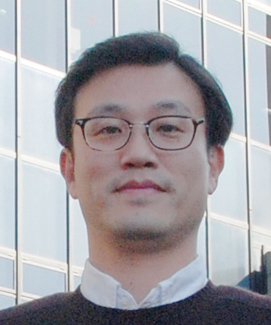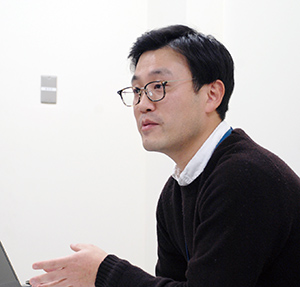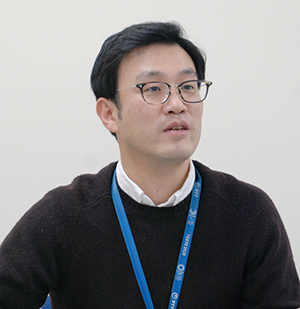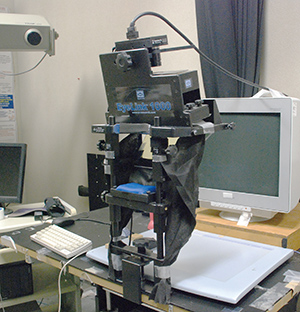 |
|||
|
|
|||
|
Rising Researchers Vol. 19, No. 7, pp. 13–16, July 2021. https://doi.org/10.53829/ntr202107ri1  Keeping the Spatial Relationship of the Eye and Arm Constant Is Important for Motor Learning. Research on Sensorimotor Control Reveals Brain Mechanisms Underlying Movement ControlOverviewThe human eye is often mentioned in the sports world in expressions such as “watching the ball.” We spoke to Distinguished Researcher Naotoshi Abekawa, who studies sensorimotor control, shedding light on the relationship between eyes and arms with a particular focus on unconscious movement. His goal is to provide new value proposals for the real world, such as sports and user interfaces. Keywords: sensorimotor control, eye-arm motor coordination, body representation About NTT’s basic research on sensorimotor control—Please tell us more about your research. I was originally interested in what makes human beings smart, and my graduation work at university was on image pattern recognition, a field that is part of the growing area of artificial intelligence (AI). After that, I became increasingly interested in understanding human beings themselves, and thus began my current research on sensorimotor control. Sensorimotor control refers to the mechanism whereby the brain processes the information acquired from the sensory organs to generate body movements. Including my master’s course, I have been studying this field for over 15 years. I have placed particular focus on the relationship between eyes and arms, and am now working on three research projects: implicit visuomotor control, mechanisms of eye-hand motor coordination, and the formation of body representations.
—What is “implicit visuomotor control”? For example, when there is something on a desk, we first look at it with our eyes, recognize what it is, know where we’ve seen it, make a decision to reach it, and finally move our arms. The process of moving through each of these steps is called “sequential processing.” Such traditional theory is a very good fit for the voluntary motor generation. On the other hand, in cases where there are severe time constraints, such as in sports, the question arises of how movements based on such complex computations can be carried out on time. This is why I focused on implicit and unconscious movement. For example, if you move the background image in a certain direction during arm motion, the arm will unconsciously follow that direction with a subconscious motor response that occurs regardless of age or gender. Although this motor response cannot be observed without very precise measurements, a series of studies by our group has demonstrated that these subconscious visuomotor control processes exist. —Tell us about the mechanisms of eye-arm motor coordination. For example, when you make breakfast or hit a ball flying toward you, your eyes move appropriately to track where your arms will move. This means that the eyes are moving in coordination with the movement of the arm. This project aims to determine whether this co-relationship also applies to subconscious movement, and if so, whether it is identical to voluntary movement or completely separate. For example, if you think about learning to ride a bike, at first you will have a hard time because you try to pay conscious attention to lots of things, but once you learn how to ride you will stop thinking so much. In our field, we call such improvement of motor skills “motor learning.” Our study has shown that the eye plays an important role in unconscious motor learning and the execution of acquired motions, and specifically, that maintaining a constant spatial relationship between the eye and the arm increases the learning effect. This new concept was also accepted in a presentation at Advances in Motor Learning & Motor Control, 2019, an international conference regarded as the most competitive in the field of motor control and motor learning. This is the project I am focusing most of my efforts on right now.
—Tell us about the formation of body representation. This project is slightly different from the two I mentioned earlier. Let’s take tennis as an example. In order to determine whether to hit back a ball flying toward you with a forehand or backhand swing, you must determine whether the ball is to your right or left. This decision must be made with reference to the body’s midline. However, unlike vision and hearing, there are no organs for perceiving the midline of your body directly. A representation of your body’s midline is likely formed based on a range of sensory organs as well as your knowledge and your experience. This project aims to find out how such body representations are formed. Specifically, through an experiment in which GVS (galvanic vestibular stimulation) electrical stimuli were transmitted to the vestibular organs of the brain, we were able to confirm the movement of egocentric body representations and the deep involvement of vestibular inputs in the body’s midline. I worked on this project while studying in London in 2015, and it has already produced results, including papers. In the future, I would like to establish a unified theory of motor control leading to an essential understanding of human beings—What areas do you expect your research to be applied to in the future? In the world of professional sports, such as baseball and tennis, there are quite a few players and coaches who refer to the eye with expressions such as “keep your eye on the ball” or “I don’t watch the ball much when I am performing at my best.” However, this is hard to explain when you consider why. I thought that the significance of such messages may lie in the idea of keeping the spatial relationship between the eye and the arm constant rather than just looking at a fixed point. By taking these ideas that are discussed in practical situations and applying them in a research setting, I believe we can uncover the mechanisms of eye-arm coordination, and leverage this knowledge to improve accuracy and efficiency in areas such as sports training and rehabilitation. Applications could also include user interfaces and virtual reality. For example, if we aim to design a user-friendly, attractive interface for humans, we need to fundamentally understand how humans sense and how they move. Human movement includes both voluntary and subconscious movement. Likewise, the “comfort” that humans feel may be closely linked not only to their voluntary movement, but also to their subconscious movement. In the medium and long term, this research will also contribute to Digital Twin Computing that IOWN (Innovative Optical and Wireless Network) aims to achieve. It should be clear that the essential understanding of human sensorimotor control that we are aiming for is key to digitally reproducing all aspects of human beings, including not only visual appearance by also inner aspects. —What do you consider NTT’s strengths to be? I think NTT’s strength lies in its close ties to experts in various fields. NTT Communication Science Laboratories, where I work, is a basic research laboratory that is focused on humans and information as its two pillars. Many researchers work there whose methods can be integrated into the field of information as well as machine learning, AI and other areas of sensorimotor generation. The Human Information Science Laboratory, of which I am a member, is also home to numerous experts on topics such as vision, hearing and touch in addition to movement. Furthermore, within the laboratory, the Kashino Diverse Brain Research Laboratory uses brain science to reveal the outstanding capabilities of the most extraordinary people with a focus on professional sports, and is producing close links between records in our laboratory environment and real-world records. Starting with the assumption of collaborating from the beginning often doesn’t work well, but I think new themes and research are often developed when different values, perspectives and techniques are mixed together. I think this is a major strength of NTT.
—Do you have a message for people who would like to work in basic research? I would like to encourage students who aspire to become researchers to just go for it when they are in doubt. Give it a shot first, and then reflect. Depth is obviously important when we think about things, but it is also important to look at data from different directions. Then, once you have put an idea together, take a look at it from a higher perspective. Research is always a continuous struggle, but I think that sticking with this repetitive process builds your own originality and values. I have recently come to realize that the saying “think like an amateur, do as an expert”* is spot on. Previously, I thought the right approach was to “think like an expert and do as an expert”—in other words, I believed that depth, specialization and almost obsessive focus were key to research success. However, research conducted this way does not have a significant impact. In fact, I have come to realize that the more impactful research results are the product of efforts to use scientific evidence in order to answer questions or understand phenomena that the general public is familiar with—things we encounter in our daily lives, or random occurrences that make us wonder. In the course of my research, I have come to think that the eye’s cooperation with the arm involves more than just acquiring more detailed visual information as thought in the past. As suggested by the common sentiment that “the eyes are windows to the soul,” the eye may also be closely related to a person’s consciousness, mindset and attention. I would like to explore these ideas further and establish a unified theory of motion that combines voluntary and subconscious movement, leading to a fundamental understanding of human beings. However, a “fundamental understanding of human beings” is a complex research theme, and there are no departments that align with it in Japanese universities. For this reason, few students possess the relevant expertise; conversely, however, this field is such that people with a variety of specialties and backgrounds can participate. NTT offers a wide range of paths, including recruitment of newly graduated students with master’s degrees and doctoral degrees, as well as mid-career and post-doctoral hires. If you are interested, please visit our website.
■Interviewee profileNaotoshi AbekawaDistinguished Researcher, NTT Communication Science Laboratories. He received a B.E. from Tokyo Metropolitan University, an M.E. from Tokyo Institute of Technology, and a Ph.D. from Kyoto University, in 2003, 2005, and 2013. He joined NTT in 2005 and has been engaged in research on human information processing. His research interests include human sensorimotor mechanisms, especially visuomotor control properties. He is a member of the Society for Neuroscience, the Japan Neuroscience Society, the Japanese Neural Network Society, and the Institute of Electronics, Information and Communication Engineers. |
|||











